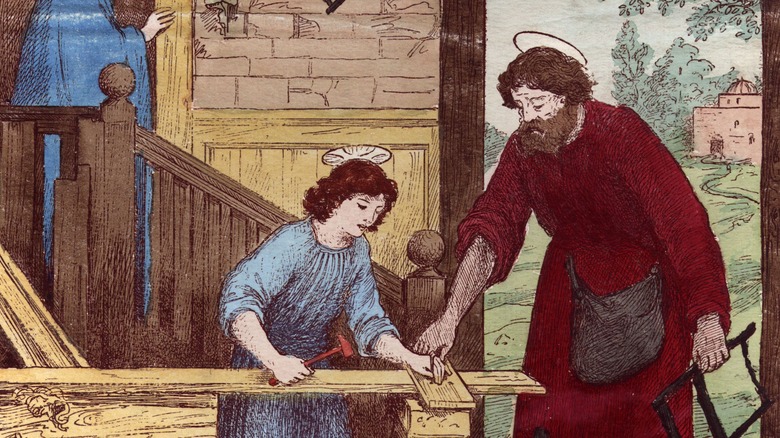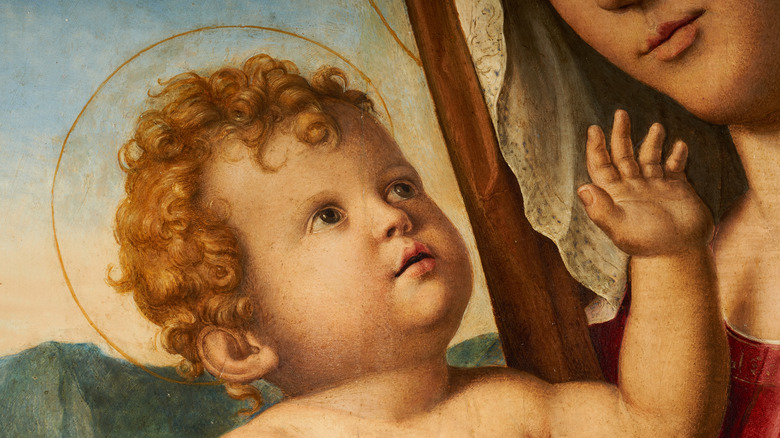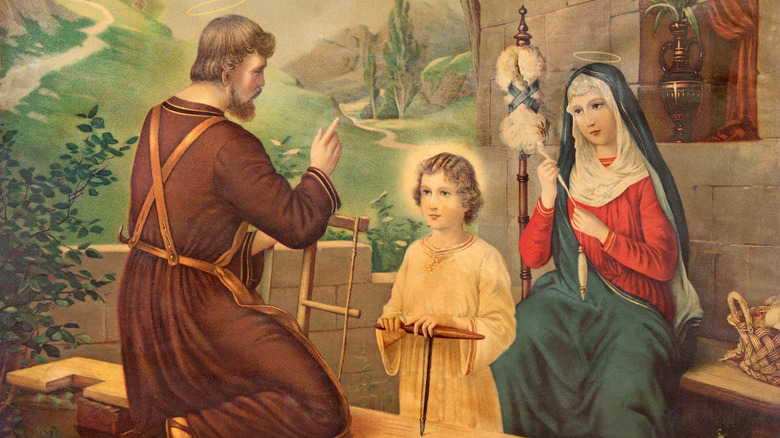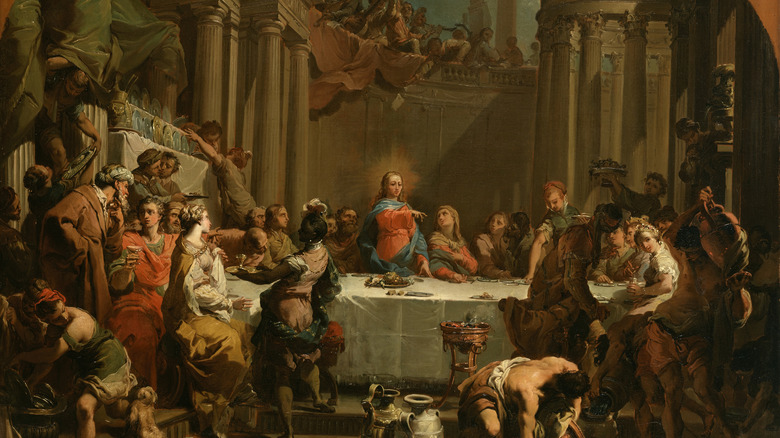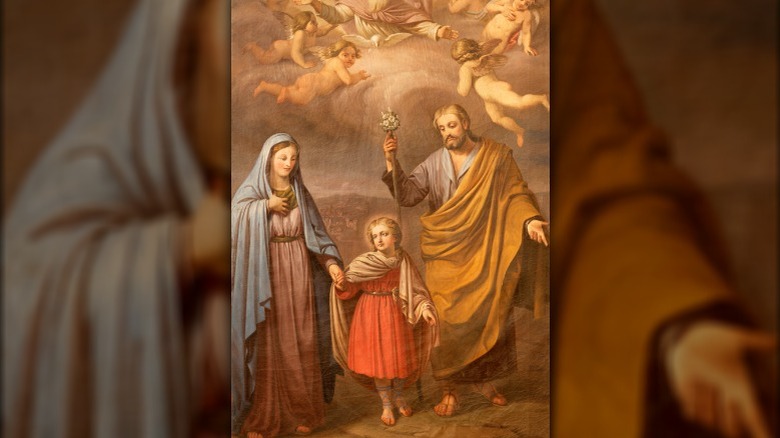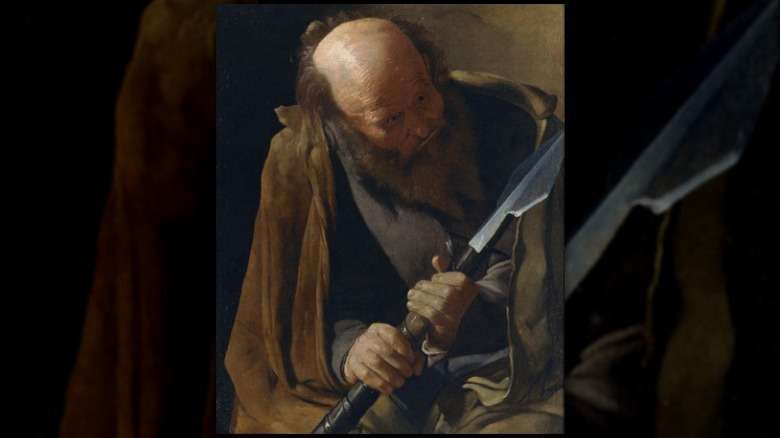Here's What Jesus' Childhood Might Have Been Like
Jesus Christ, the Messiah, the Everlasting Father, someone who may not have even existed — whatever you know him as, he has long fascinated humans of various cultures and backgrounds, and his story is part of all Abrahamic religions. But his portrayal across related scripture varies greatly, and what we know of his childhood is limited and debatable. The canonical Christian Bible says very little, and Judiasm's Torah does not mention "Jesus" at all, instead mentioning his Hebrew name, Yeshu. In Islam's Quran, he is mentioned 97 times as Isa, along with some claims of his childhood doings. Non-canonical Christian works like the Infancy Gospel of Thomas have much more to say, though the legitimacy of its stories is highly contested, and it was considered heretical by some early leaders in the Catholic Church.
Much of what we can gather about Jesus' early days from such works is unlikely to ever be agreed upon or confirmed for certain. The best we can do is look to such stories for hints of what his upbringing might have been like. And some purported tales may even be reflections of what people thought of Christianity as a whole at the time. Here's what Jesus' childhood might have been like.
A large, religious family — descended from violence
The Gospel of Matthew says that Joseph and Mary were set to be married when she became pregnant with Jesus Christ, her first-born son. A virgin at the time, the scripture suggests she conceived Jesus through the Holy Spirit without sexual intercourse. According to some sources, they had at least six other children, though whether from Joseph's previous marriages or consummation of their own after Jesus' birth is debated. Matthew 13 says Jesus had four "brothers" — James, Joses, Simon, and Judas — and at least two "sisters." The Catholic Church regards these as his cousins and believes Mary remained a virgin her whole life.
According to Matthew, Jesus grew up in a devoutly religious household. His parents made pilgrimages to Jerusalem each year for the feast of Passover and Days of Unleavened Bread, and when he was 12, they brought him on one of their annual trips to the Holy City. Luke 2:40 says up until the age of 12, Jesus "grew and became strong; he was filled with wisdom, and the grace of God was on him." In the Quran's Surat Maryam 19, Jesus — or Isa — even speaks from the cradle: "Indeed, I am the servant of Allah . He has given me the Scripture and made me a prophet."
But Matthew also provides the genealogy of Jesus Christ in the tradition of Jewish writing, where who one is descended from is considered extremely important. This helps to paint a picture of Jesus' family tree and the violent, checkered lives within it, especially when knowing the history of figures like David from the Old Testament (i.e. the Hebrew Bible). The collection of writings is full of betrayals and violent clashes. According to Harbor Church Honolulu, "Matthew had a point to make: Jesus came to show God's grace to everyone. Righteous and unrighteous. Men and women."
Stories of healing and revival
The Infancy Gospel of Thomas was not canonized into the New Testament and contains stories of Jesus when he was between 5 and 12 years old and living in Bethlehem. Some describe him using his alleged healing powers during this time. In one account, Thomas the Israelite (generally believed to be St. Thomas the Apostle) writes of a young man who was saved by a 5-year-old Jesus after cutting his foot in half and dying from blood loss. "[Jesus] pressed through the crowd, and laid hold of the young man's wounded foot, and he was cured immediately," the gospel reads. "And He said to the young man: Rise up now, split the wood, and remember me."
Also at 5 years old, Thomas claims Jesus was playing with a child who died after falling from the upper floor of a house. The boy's parents came to the scene and blamed Jesus, who yelled: "Zeno — for that was his name — stand up, and tell me; did I throw you down?" "And he stood up immediately," Thomas wrote, "and said: Certainly not, my lord; you did not throw me down, but hast raised me up."
Some believe that the Catholic Church was afraid of the Gospel of Thomas and what it contained, which led to the suppression of the work. According to Catholic Answers, the reason for its exclusion from the canonical Gospels is much simpler: "[It] is a fake." The advocacy group notes that the document was written around one or two centuries after apostle Thomas died. And though the outlet claims the text does contain some "authentic sayings of Jesus" given its use of the canonical Gospels as part of its foundation, it also "contains a bunch of stuff that is silly." "It wasn't written under divine inspiration," the media ministry continues. "It doesn't belong in the Bible."
Manipulating laws of nature
Through biblical text, both canonical and noncanonical, as well as in the Quran, Jesus is described as having powers over the laws of nature. The canonical gospels portray some of the most famous and well-known of his nature-bending miracles: turning water into wine, healing blindness, calming a storm, etc. But only in the non-canonical works does he conduct such mystical acts as a child. In the Infancy Gospel of Thomas and Gospel of Pseudo-Matthew, he is described as sowing many seeds of corn — the former says from one grain of corn, the latter "a little wheat." Elsewhere in the Gospel of Thomas, he stretches a wooden beam into a longer one, to the amazement of his father. In the Quran, Jesus also has such powers at a young age, creating living birds from clay as a child — a story that mirrors a tale in the Gospel of Thomas (more on that later).
It is of course this discrepancy that is one of the biggest clashes between canonical New Testament works and its apocryphal writings (and one of many contradictions between Christian and Islamic writings on Jesus). In a piece for Christianity.com, Christian apologist James Warner Wallace suggests that though Jesus held his divine power for his entire life, he did not show it until later. "The best and most reasonable inference from the ancient historical record related to Jesus is that He waited until his public ministry (as an adult) to reveal His power to His disciples and the world He came to save," he wrote. "Jesus did not perform miracles as a child."
A problem child?
Elsewhere in the Infancy Gospel of Thomas, Jesus is portrayed as having a dark side. It's a depiction that conflicts with many of the popular portrayals of the Son of God, which has of course fueled arguments that the non-canonical work was suppressed for the information it contained and assertions that it is historically meritless. In one story, Jesus lashed out at a boy who ran into his shoulder, cursing him the death. "You shall not go back the way you came," he allegedly said to the boy, who "immediately ... fell down dead." The boy's parents blamed Joseph for the death, and in retaliation, Jesus struck them blind. Elsewhere, he cursed another boy for interrupting his playing, causing him to "wither" and die. In yet another account Jesus even curses his teacher, killing him immediately.
In a research article published in Church History, historian Kristi Upson-Saia notes that the depiction of Jesus in these stories is a far-cry from the canonical tales. "In these scenes, Jesus appears to be a mercurial young boy whose anger is triggered by the slightest nuisance or insult and who seeks harsh vengeance," she wrote. According to Upson-Saia, these accounts were likely created by opponents of Christianity — a strategic attempt to "malign" Jesus as "self indulgent, ignoble, unmanly, and a threat to the community."
Vivification of the Sparrow
In June 2024, a 1,600-year-old papyrus fragment provided yet more possible information on Jesus' childhood. The 4-by-2-inch scrap was discovered in a Hamburg State and University Library archive. According to a press release from Humboldt University of Berlin, it contains 13 lines of Greek letters, with about 130 characters in total.
The tablet originates from 284 to 641 A.D. and is from — you guessed it — the Infancy Gospel of Thomas, believed to be written in the 2nd century. In the press release, the researchers claim that the fragment contains part of the "Vivification of the Sparrows" story, which is very similar to the Quran's passage about Jesus making birds from clay (written from 610 to 632 A.D.). "Jesus plays at the ford of a rushing stream and moulds twelve sparrows from the soft clay he finds in the mud," they wrote. "When his father Joseph rebukes him and asks why he is doing such things on the holy Sabbath, the five-year-old Jesus claps his hands and brings the clay figures to life." It's the second miracle in the apocryphal Gospel of Thomas, contradicting the Gospel of John, which says his transformation of water to wine as an adult was the first miracle.
